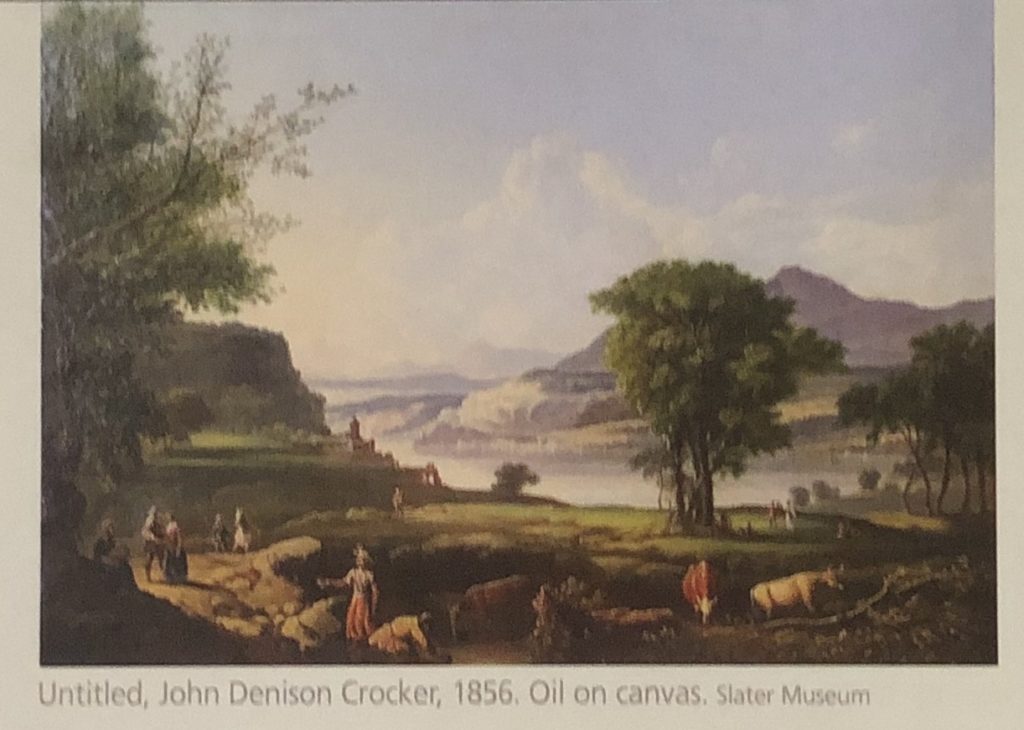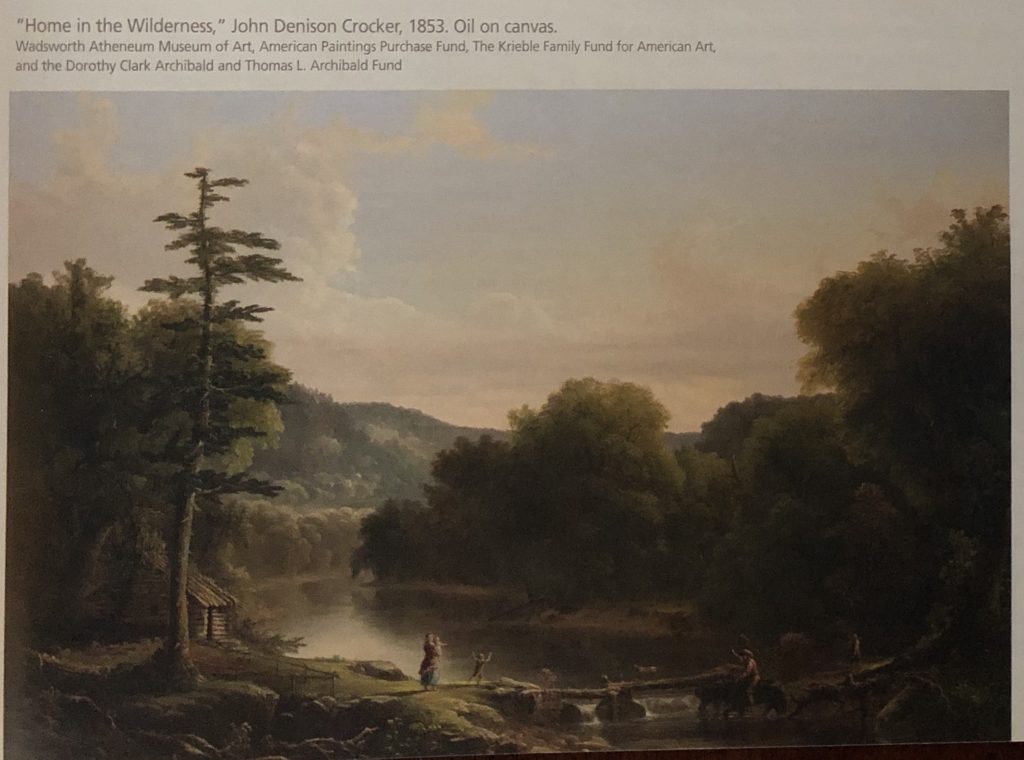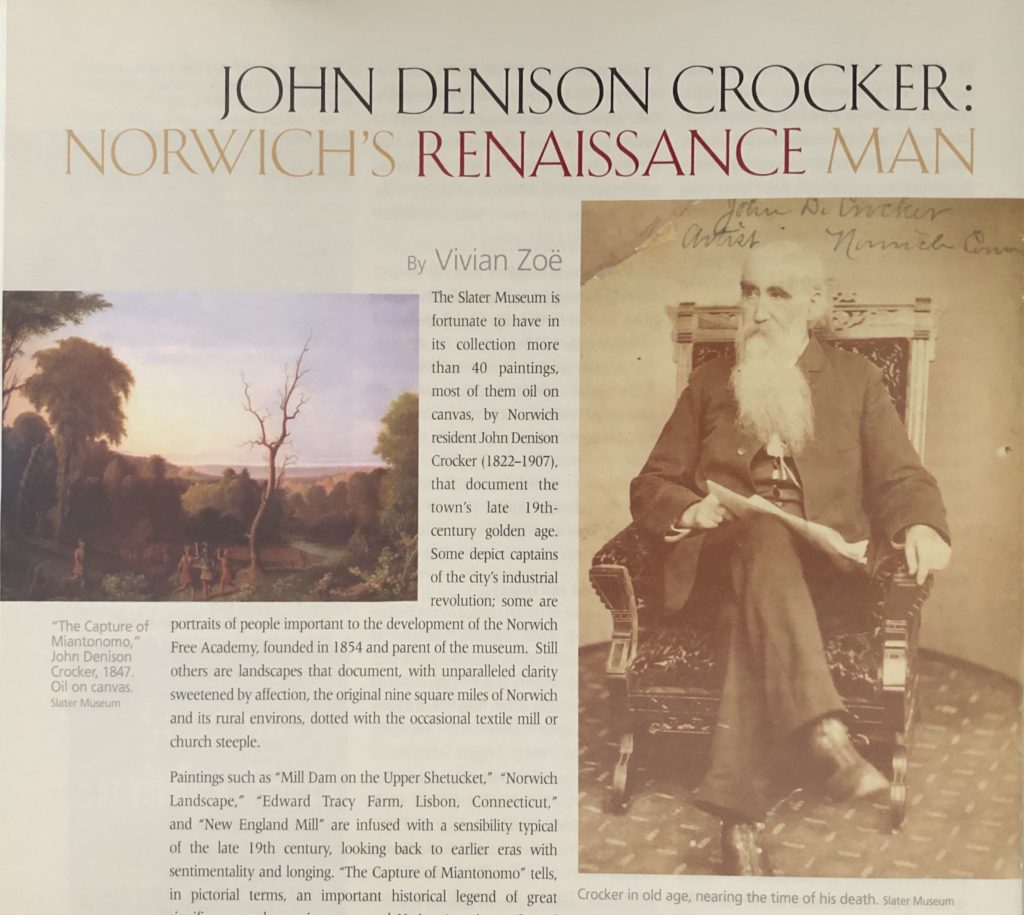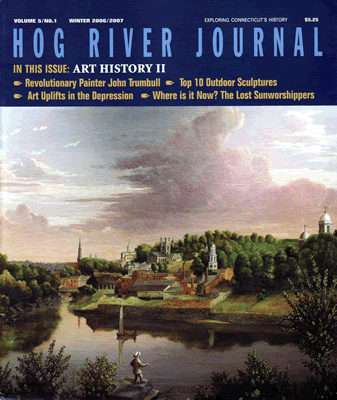(c) Connecticut Explored Inc. WINTER 2006/07
Subscribe/Buy the Issue!
The Slater Museum is fortunate to have in its collection more than 40 paintings, most of them oil on canvas, by Norwich resident John Denison Crocker (1822 – 1907), that document the town’s late 19th-century golden age. Some depict captains of the city’s industrial revolution; some are portraits of people important to the development of the Norwich Free Academy, founded in 1854 and parent of the museum. Still others are landscapes that document, with unparalleled clarity sweetened by affection, the original nine square miles of Norwich and its rural environs, dotted with the occasional textile mill or church steeple.
Paintings such as “Mill Dam on the Upper Shetucket,” “Norwich Landscape,” “Edward Tracy Farm, Lisbon, Connecticut,” and “New England Mill” are infused with a sensibility typical of the late 19th century, looking back to earlier eras with sentimentality and longing. “The Capture of Miantonomo” tells, in pictorial terms, an important historical legend of great significance and meaning to several Native American tribes of eastern Connecticut and Rhode Island and anticipates the American narrative paintings of the west, reminiscent of Albert Bierstadt’s work. On an aesthetic level, Crocker’s work is comparable to any of his era.
In style, Crocker’s landscapes follow conventions of subject matter, arrangement, placement within the picture plane, and specific details, such as the lone woodsman or pioneer dwarfed by his natural surroundings or the soaring luminous sky, that are common to both the Hudson River and White Mountain painters. In its historical value to southeastern Connecticut, the state, and the region, Crocker’s work can be likened to that of Benjamin West, Thomas Cole, and Frederic Church. In his mastery of the medium, Crocker excels. Layers of paint are built up and topped with the tiniest dabs of contrasting color to represent virtually every leaf on a tree. The texture of those leaves is applied in marked contrast to the smooth, reflective rendering of a languid river below. The image’s triangulated design draws the viewer ever deeper, only to send the eye back to the canvas’s outer edge.
A City of Inspiration
The sentiment evident in Crocker’s work could stem from the time and place in which he lived. One of the earliest towns settled in Connecticut, Norwich was incorporated in 1659. At the time, relations between the native tribes and the Europeans were intimate. The city began to emerge as an economic powerhouse in the middle of the 18th century, producing titans of American history who would sign the Declaration of Independence, provide early leadership (and fall from grace, as in the case of Norwich-born traitor Benedict Arnold) before, during, and after the Revolutionary War, go on to establish cities in the “Western Reserve,” and invent remarkable innovations. By 1774, within Connecticut Norwich was second only to New Haven in population and tax list.
The shipping trades, coupled with surrounding agriculture, contributed mightily to Norwich’s early success. For more than a century the city grew and prospered, becoming an essential supplier of armaments, textiles, hardware and other supplies to the Union’s battle to re-unite the young country. In the late 19th century, Norwich was reaching the zenith of its wealth and influence. Manufacturing and shipping of an immense array of products allowed city leaders to offer excellent health care through Backus Hospital (founded 1893), the best in independent education for all students regardless of economic or ethnic background through the Norwich Free Academy (founded 1854), and access to the world’s greatest art through the Slater Museum (1888), whose opening was attended by dignitaries arriving by chartered private trains from New York City and Boston. The Boston train carried the socialite Isabella Stewart Gardner and Harvard art history professor Charles Eliot Norton, director of the Boston Museum of Fine Arts Charles G. Loring, and the president of M.I.T., Francis A. Walker. A Hartford contingent included Henry Barnard, credited as the father of American public education.
 John Denison Crocker’s life virtually followed the arc of Norwich’s greatest fortune during its industrial revolution to the beginning of its plummeting descent. Like the city, his success as a youth was due largely to his personal natural resources. Like Norwich, he assayed several pursuits, including his painting, and prospered through their diversity.
John Denison Crocker’s life virtually followed the arc of Norwich’s greatest fortune during its industrial revolution to the beginning of its plummeting descent. Like the city, his success as a youth was due largely to his personal natural resources. Like Norwich, he assayed several pursuits, including his painting, and prospered through their diversity.
From Artisan to Artist
Much too little is known about John Denison Crocker; his early history is therefore a puzzle yet to be fully pieced together. Born in Salem, Connecticut in 1822, he spent most of his life in Norwich, dying there in 1907. At the age of nine, he was working for a wagon maker. At 12 he was apprenticed to a silversmith and left that trade to work at the shop of a furniture maker and restorer. It was here that he was first exposed to portrait painting. A portrait brought to the furniture shop for varnishing when he was 17 apparently captivated him; upon seeing it, he determined to become a portrait painter. Characteristic of a teenager’s sense of invincibility, he was sure he could paint. His later work proved he was right. At age 25, in 1847, he moved to New York. He married Harriet Elizabeth Dillaby at age 27 in 1849, and they had eight children.
Sources including Frances Manwaring Caulkins’s History of Norwich, Connecticut and Mantle Fielding’s Dictionary of American Painters, Sculptors & Engravers allude to Crocker’s having sought advice, perhaps lessons or critique, from Charles Lanman (1819 -1895) of Norwich, a respected artist belonging to a prominent family that included shipping magnates, merchants, mayors, factory owners, a Navy commodore and a U. S. senator. Lanman, a landscape painter who studied with Asher Durand, made a living writing for many publications, including British journals, about the wilds of the new world. Perhaps it was his influence that eventually led Crocker, essentially self-taught, to attempt to document the rivers, harbors, trees, agricultural land, and livestock of his native southeastern Connecticut.
The Hudson River School of painting may also have influenced Crocker. Founded by Thomas Cole in New York in the first half of the 19th century, the movement included a ritual wherein artists spent summers in the Catskill and Adirondack mountains, absorbing and finding inspiration in the uniquely American wilderness. (It is likely, but not certain, that Crocker took part in this ritual.) While living in New York City, Crocker was no doubt exposed to the still-growing movement. It was, in fact, a Connecticut Yankee, Daniel Wadsworth of Hartford, who supported and promoted Cole’s early work, so a style we associate with New York might be said to have deep Connecticut roots.
Crocker’s work also can be likened to that of the White Mountain Painters, a group generally acknowledged to have been founded in North Conway, New Hampshire by Benjamin Champney (1817-1907). A New Hampshire native, Champney was inspired on his first visit to the White Maintains in the 1830s. By 1853, he had acquired a house in North Conway and invited other painters to summer there with him. Much like Connecticut’s Florence Griswold [See “The Spirit of Miss Florence Restored, HRJ Winter 2005/2006.], he enabled artists to focus on their painting and to share ideas at the end of their days en plein air. At least one of Crocker’s paintings in his White Mountain group, “View in New Hampshire,” remains extant and is owned by the Smithsonian Institution in Washington, D.C.
Portraits First
Initially, while still living in Norwich, Crocker devoted his efforts to portraiture. Judging from portraits in the museum’s collection, in this, too, he was a prolific documentarian. He painted numerous portraits of his wife and daughters and captured on canvas founders and leaders of the Norwich Free Academy. In these works, Crocker recorded Norwich residents at a time when photography was just becoming available to the masses. The somewhat stiff, but minutely detailed quality of his portraits suggests that he used photographs to refresh his memory of a likeness and to present accurate representations of clothing and accessories.
 Crocker’s portraits were marvels of documentation. “Harriet Elizabeth Dillaby Crocker (and child),” one of several portraits of relatives he painted in the mid-19th century, and “Celeste Lydia Kenyon Beckwith,” c. 1876, depict brooches, lace, earrings, rings, a buckled watch strap and a gold watch-tie with nearly photographic accuracy. The portrait of his daughter Harriet Elizabeth (“Daughter of the Artist”) as a young girl has her encircled with an oval frame and necklace of leaves of both representational and fantastical qualities.
Crocker’s portraits were marvels of documentation. “Harriet Elizabeth Dillaby Crocker (and child),” one of several portraits of relatives he painted in the mid-19th century, and “Celeste Lydia Kenyon Beckwith,” c. 1876, depict brooches, lace, earrings, rings, a buckled watch strap and a gold watch-tie with nearly photographic accuracy. The portrait of his daughter Harriet Elizabeth (“Daughter of the Artist”) as a young girl has her encircled with an oval frame and necklace of leaves of both representational and fantastical qualities.
Henry B. Norton, who arrived in Norwich a pauper from Branford but became president of the Norwich & New York Transportation Company, is represented by two Crocker portraits in the Slater’s collection. Norton’s company operated steamships, hauling the city’s prodigious product to New York for distribution worldwide. Shortly after his arrival in Norwich, Norton also became a partner in Backus and Norton, which later became Norton Brothers, dealing in wholesale groceries. He subsequently served as the president of the Attawaugan Mill, a large manufacturer of cotton cloth. Henry B. Norton was a founding trustee of the Norwich Free Academy and the Norwich Y.M.C.A., leaving $200,000 in 1891 to fund construction of a new building at the academy.
A portrait of William W. Backus, scion of a family whose prodigious wealth came from the early establishment of a foundry and gun manufactory in the Yantic section of Norwich, is also in the collection. Latter-day researchers have conjectured that Backus competed with William A. Slater for the title of top philanthropist in the city. William was the son of John Fox Slater, who had brought the textile industry from Rhode Island to Connecticut. The family became fabulously wealthy; the son, for example, commissioned a private yacht at a cost of $250,000 in 1894. By comparison, the entire Slater Memorial Hall, with its elaborate light fixtures, carved brownstone, exotic woods, stained glass, marble trims, and terra cotta ornament, cost $100,000 to build in 1886. William Slater supported the operations of the museum with an annual gift until his departure from the city in 1896. Backus won the battle, getting his name on the city’s hospital, though Slater’s gift to found the hospital was larger.
Crocker also painted a portrait of Colonel Charles A. Converse, a founder of Hopkins & Allen Manufacturing Company, which made derringers, the ubiquitous handguns that legend says were frequently used, after words failed, to settle a card game. Among gun makers, Hopkins & Allen was considered third in the nation behind Colt in Hartford and Winchester in New Haven. Although William Slater has been credited with persuading Colonel Converse to donate funds sufficient to build a new art building at the Norwich Free Academy, Hannah Dodge, the wife of the Academy’s Art School director Ozias Dodge, spoke of her efforts to charm Converse. She recounted many years later that she had satisfied his prurient interests by sitting on his lap, sealing the deal. The Slater Museum’s changing gallery is named the Converse Art Gallery, and Crocker’s portrait of the patron hangs permanently in it.
Hanging in Norwich City Hall, commanding council chambers from a perch above the dais that accommodates the board table, is Crocker’s spectacular portrait of John Duane Park, Connecticut Supreme Court chief justice from 1874 to1889. Judge Park was a man of considerable standing, both physically and intellectually. He was not without his peculiarities, though, and, in an article published in 1991 in the journal “Forum” of the Connecticut Trial Lawyers Association, attorney Wayne G. Tillinghast reveals interesting details about Park’s politics as a member of the nascent Republican Party, his home life, including his wont to read in a tree-house built with a gang plank directly from the tree to an upper floor of his Laurel Hill home, and a possible temporary insanity wherein he shot at noisy late-night swimmers on the banks of the Thames, who had disturbed the judge’s sleep.
Crocker did not universally sign his work; the relatively large signature on the Park portrait, located conspicuously along the side of a table upon which the judge leans, reflects Crocker’s justifiable satisfaction with this particular work.
Present-day families whose lineage goes back to the original settlement of Norwich own Crocker portraits of their ancestors and paintings depicting their farms and fields. The Norwich Harbor was a favorite motif, and Crocker painted it from many angles. The accuracy of his work can be measured by photographs of the same locations taken 50, 100, and 150 years later. Only the layering of new architecture on old has changed the scenes.
Crocker’s Landscapes
In many ways, Crocker’s work, especially the landscapes, owes a huge debt to his artistic forebears, and while he was essentially unschooled, he clearly studied earlier work. As in the earlier work of Alvan Fisher and Asher Durand, cows play a starring role in his numerous generic images of country scenes. Indeed, one of the criteria the Slater Museum has come to use when it is asked to help authenticate an unsigned Crocker is the presence and placement of cows. Crocker’s particular rendering of leaves and his bower of trees form a proscenium arch, drawing the viewer ever deeper into the picture. The formula might be called a convention among American landscape painters of the 18th and 19th centuries. Making that convention his own, though, Crocker rarely fails to include one dead, though graceful and seemingly animated, tree.
Crocker’s work is nostalgic yet ambivalent in its depiction of panoramic and uniquely American landscapes. Always touched by human intervention, these vistas might include a tiny cabin in a Herculean forest, a train chugging through cultivated fields, a brick and granite mill building in the distance along a river bank, a church steeple tucked among the autumn foliage, a utilitarian colonial farmhouse, an elegant high Victorian mansion, a single sailboat on the glassy river.
 Betsy Kornhauser, Krieble Curator of American Painting & Sculpture and Associate Director of the Wadsworth Atheneum Museum of Art in Hartford has said of Crocker, “As a painter of the American landscape, John Denison Crocker followed in the footsteps of more prominent 19th century artists, in particular, Thomas Cole …. The works of Cole and his student, Hartford native Frederic Church, hung in the Wadsworth Atheneum in Hartford, which opened to the public in 1844, and where Crocker would have had access to study their work. Crocker would later pay homage to Cole when he painted ‘Home in the Wilderness’ (1853, in the collection of the Wadsworth Atheneum) which was inspired by two paintings by Cole of the same subject. … All three paintings deal with the subject of white settlement of the frontier. Families living in log cabins thrive in bucolic wilderness settings.”
Betsy Kornhauser, Krieble Curator of American Painting & Sculpture and Associate Director of the Wadsworth Atheneum Museum of Art in Hartford has said of Crocker, “As a painter of the American landscape, John Denison Crocker followed in the footsteps of more prominent 19th century artists, in particular, Thomas Cole …. The works of Cole and his student, Hartford native Frederic Church, hung in the Wadsworth Atheneum in Hartford, which opened to the public in 1844, and where Crocker would have had access to study their work. Crocker would later pay homage to Cole when he painted ‘Home in the Wilderness’ (1853, in the collection of the Wadsworth Atheneum) which was inspired by two paintings by Cole of the same subject. … All three paintings deal with the subject of white settlement of the frontier. Families living in log cabins thrive in bucolic wilderness settings.”
Creative Beyond the Canvas
Crocker’s listing as a painter in Norwich city directories indicates that he would have been able to support his large family with this work. But Crocker was also an inventor, creating patent medicines and mechanical equipment. He developed a cure-all called “Crocker’s Magical Stomach Powders,” the label of which (doubling as a wrapper) presents the philosophical, social, and political opinions of the manufacturer and guarantees the contents to be “a sure cure for Indigestion and all Bowel Difficulties and Colds.” Further, the label claims that “If taken in time these powders will ward off all infections and diseases.”
Crocker, perhaps informed by a knowledge of herbs and plant extracts, produced and distributed several well-received varnishes and coatings, including a boot polish and water-proofing agent. The Slater’s archives include a letter dated July 19, 1899 from the British-born New York portrait painter Seymour J. Guy (1824-1910) that says, “The varnish or gloss applied by you to my two little pictures is as far as I am able to judge of it in this short time, an excellent article for artistic use, both as a varnish and as a painting vehicle. In a few days it dries firmly with a desirable gloss, and the coloring of the picture is charmingly revivified. I shall not hesitate to use it for either of the above purposes.”
Like landscape painter Aaron Draper Shattuck (1832-1928), Crocker invented a canvas stretcher system. Working with partner Junius Americus Brand, Crocker developed a stretcher featuring a well-concealed iron miter bracket inserted in a slot at the joint between the wood battens. The metal piece serves both to hold the wood elements together and to keep the assemblage from twisting or becoming out of square. Shattuck’s more elaborate invention was applied to the surface of the wood battens and provided an element of ornamentation to the back of the canvas. Crocker must have approved of Shattuck’s “key” system, because he used Shattuck’s stretchers in his own work, including several of his canvasses in the Slater collection.
Crocker’s powers of observation in portraiture and landscape painting, as well as in researching materials and techniques for developing “modern” goods, make him a clear product of the industrial revolution. A realization that industrialization would make a permanent mark on Norwich might have prompted him to record, and thus preserve, his family, fellow Norwichians, and the city’s agrarian environs on canvas. Though never receiving much recognition outside of Norwich, much of his work shows a pure, visionary genius. His desire to stay “home” after his brief foray in New York, committing to his family and to Norwich, may have prevented him from acquiring a more global reputation. Some of his work betrays his struggle for excellence, with poorly rendered figures and other clumsy touches. But those paintings that succeed do so mightily.
Vivian Zoë is executive director of The Slater Museum in Norwich. She previously wrote “Noah Webster: A Connecticut Yankee Doodle Dandy” in the Spring 2003 issue of HRJ.
Explore!
“The Slaters Go Round the World,” Winter 2011/2012
“Embracing Ellis Ruley,” Winter 2018-2019
Read more stories about Connecticut’s Art History on our TOPICS page.
Sources:
Caulkins, Frances Manwaring; History of Norwich, Connecticut, From Its Possession by the Indians, to the Year 1866, Hartford: Case, Lockwood and Company, 1866
Kornhauser, Elizabeth Mankin; “Daniel Wadsworth and the Hudson River School,” Hog River Journal, Volume 3, Number 1, Hartford: Hartford Public Library, November, December, 2004/January 2005
Lathrop, Arthur L.; Victorian Norwich, Salem, Mass: Higginson Book Company, 1999
Leavens, Francis J.; The Portraits Hung in the Slater Memorial Hall and other Academy Buildings, Norwich, CT: Norwich Free Academy Press, 1922
Deák, Gloria Gilda; Picturing America, 1497-1899: prints, maps, and drawings … of the territory that is now the United States, Princeton: Princeton University press, 1988
Flexner, James Thomas; Nineteenth Century American Painting, New York: G. P. Putnam’s Sons, 1970
French, H. W.; Art and Artists in Connecticut, New York: Da Capo Press, 1970
Groce, George C. and David H. Wallace; The New York Historical Society’s Dictionary of Artists in America, 1564-1860, New Haven, Yale University Press, 1979 (revised)
Opitz, Glenn B.; Mantle Fielding’s Dictionary of American Painters, Sculptors & Engravers, Poughkeepsie, New York.:Apollo, 1983 (revised)
Stebbins, Theodore E.; The Hudson River School: 19th Century American Landscapes in the Wadsworth Atheneum, Hartford: Wadsworth Atheneum, 1976
Taylor, Joshua C.; America as Art, Washington, D. C., Smithsonian Institution, 1976
The Web site www.whitemountainart.com, 2006
Many thanks to Mary-Anne Hall, education coordinator for the Slater Museum, for her research assistance and to Susan Frankenbach, collections manager of the Slater Museum, for her photography.


